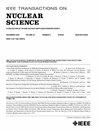A Position Sensitive Detector With Real-Time Gamma/Neutron Discrimination Capability
IF 1.9
3区 工程技术
Q3 ENGINEERING, ELECTRICAL & ELECTRONIC
引用次数: 0
Abstract
In recent years, the demand for a gamma and neutron camera with real time discrimination capabilities has emerged in nuclear physics and medical imaging fields. Specifically, in the field of hadrontherapy, prompt gamma imaging (PGI), a technique for range verification purposes, is strongly affected by the presence of a large neutron background, which can limit the possibility to perform precise range monitoring, especially in the framework of carbon ion radiation therapy (CIRT). This work focuses on the design and development of a compact camera with gamma/neutron discrimination to perform range verification in hadrontherapy, exploiting the gamma signal while discarding the uncorrelated neutron component. Thanks to its dual imaging capability, neutron images can still be stored and used in other applications. Pulse shape discrimination (PSD) was selected as the method for gamma/neutron discrimination after evaluating several techniques. Among the available options, we selected a Cs2LiYCl6:Ce (CLYC) inorganic scintillator as the optimal choice to perform PSD. The detector, based on a具有实时伽马/中子识别能力的位置敏感探测器
近年来,在核物理和医学成像领域出现了对具有实时识别能力的伽马和中子相机的需求。具体来说,在强子治疗领域,快速伽马成像(PGI),一种用于范围验证目的的技术,受到大中子背景存在的强烈影响,这可能限制执行精确范围监测的可能性,特别是在碳离子放射治疗(CIRT)的框架中。这项工作的重点是设计和开发一种具有伽马/中子识别的紧凑型相机,用于在强子治疗中进行距离验证,利用伽马信号,同时丢弃不相关的中子成分。由于其双重成像能力,中子图像仍然可以存储并用于其他应用。在对几种方法进行评价后,选择脉冲形状判别法(PSD)作为伽马/中子判别方法。在可选方案中,我们选择了Cs2LiYCl6:Ce (CLYC)无机闪烁体作为进行PSD的最佳选择。该探测器基于5 × 5 × 2 × cm的CLYC晶体,由SiPM瓦片和紧凑型电子器件读出,获取并转换实时数字PSD系数。使用四个16通道自定义增益幅度调制多通道专用集成电路(GAMMA asic)允许存储通道的幅度信息,允许检索单片晶体中相互作用的粒子点并获得psd分辨率图像。通过实验测量和光束测试验证了系统的识别能力,并成功地对其实时PSD成像能力进行了初步评估。
本文章由计算机程序翻译,如有差异,请以英文原文为准。
求助全文
约1分钟内获得全文
求助全文
来源期刊

IEEE Transactions on Nuclear Science
工程技术-工程:电子与电气
CiteScore
3.70
自引率
27.80%
发文量
314
审稿时长
6.2 months
期刊介绍:
The IEEE Transactions on Nuclear Science is a publication of the IEEE Nuclear and Plasma Sciences Society. It is viewed as the primary source of technical information in many of the areas it covers. As judged by JCR impact factor, TNS consistently ranks in the top five journals in the category of Nuclear Science & Technology. It has one of the higher immediacy indices, indicating that the information it publishes is viewed as timely, and has a relatively long citation half-life, indicating that the published information also is viewed as valuable for a number of years.
The IEEE Transactions on Nuclear Science is published bimonthly. Its scope includes all aspects of the theory and application of nuclear science and engineering. It focuses on instrumentation for the detection and measurement of ionizing radiation; particle accelerators and their controls; nuclear medicine and its application; effects of radiation on materials, components, and systems; reactor instrumentation and controls; and measurement of radiation in space.
 求助内容:
求助内容: 应助结果提醒方式:
应助结果提醒方式:


